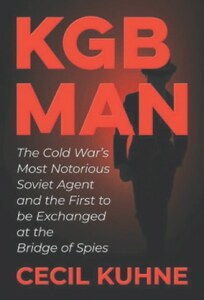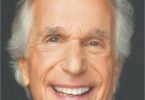KGB Man
By Cecil Kuhne
Knox Press
ISBN: 978-1637585924
208pp.
You may have watched Steven Spielberg’s award-winning 2015 film Bridge of Spies, where Tom Hanks plays James B. Donovan, a lawyer instrumental in bringing back two American nationals in exchange for a Russian spy during the height of the Cold War. But many may not know that the two-time Oscar-winning actor was playing a real-life character in the movie, and a lot went on behind the scenes before the swap was even considered.
Cecil Kuhne’s KGB Man: The Cold War’s Most Notorious Soviet Agent and the First to be Exchanged at the Bridge of Spies not only talks about the entire case but also the capture and trial of the Russian spy Rudolf Abel, something the film skipped so that it could go beyond the arrest and the case. The author brings forth details of the case that weren’t known to the general public and makes the readers understand what happened when the case was being heard in a US court.
If you didn’t know that former KGB operative Reino Häyhänen was responsible for betraying his countryman, that Abel moved around using multiple aliases, and that his recklessness resulted in his capture, you need to get your hands on this book. The author uses his experience as a litigator and a travel enthusiast to paint a picture of the United States of the late 1950s, where life was not as simple as it is often made out to be.
According to the author, it wasn’t the ideal time to be a spy in either the United States or the USSR, who were at loggerheads during the Cold War. Since this war wasn’t being fought on the ground in the two countries involved, both the superpowers had dispatched spies to each other’s soil to understand the other side’s technological advancements. Being caught on either side was as bad as being executed, but not when you had a lawyer like James B. Donovan on your side.
A recent book goes behind the scenes to explain the strange case of a Soviet spy’s arrest in the US and trial in 1957, and his release in 1961
The author, in a very matter-of-fact way, takes the readers back into the days when the USA and the USSR were recovering from the after-effects of the Second World War, a war where they had combined to beat their common enemy, Hitler’s Nazis.
Fast forward to 1948 and you get to meet Rudolf Abel, who came to the US illegally, took over the name of a deceased American, and began his espionage activities, which continued till his arrest in 1957.
Divided into 14 chapters, the author then introduces the other characters in this story, the lawyer Donovan who saves Abel from a death sentence, the co-conspirator Häyhänen who ratted out Soviet intelligence operatives in the US for greener pastures and a US Army mechanic, who was formerly attached to the embassy in Moscow and was also essential to the espionage network.
These chapters feature the conduct of the accused, the accuser, and those who helped both in the trial. The main battle here is fought between the lawyers of Häyhänen and Abel; the prosecutor trying to convince the jury that Abel must be punished for being a spy, and the defendant’s lawyer arguing that the alleged spy’s arrest wasn’t done legally.
Coded messages, photographs and microdots, the book has everything one would find in a spy thriller from the 1960s and the 1970s. However, in his haste to bring the details of the KGB man’s trial in print, Kuhne goes off track. Instead of covering the trial as a narrative, he copy-pastes its entire transcript, which is tedious to plough through.
If you didn’t know that former KGB operative Reino Häyhänen was responsible for betraying his countryman, that Abel moved around using multiple aliases, and that his recklessness resulted in his capture, you need to get your hands on this book. The author uses his experience as a litigator and a travel enthusiast to paint a picture of the United States of the late 1950s, where life was not as simple as it is often made out to be.
When I got my hands on this book, I was looking for something that excited me as much as the Bridge of Spies. I was hoping for the full account of Abel’s espionage work (which was all there), the events that led to his arrest(present), and finally his conviction and surprising return to Russia. I was also hoping to find those details that the film skipped but then realised that the author seems to have penned the book more for himself rather than for his readers, which bothered me and might trouble fellow spy enthusiasts too.

The “wrinkle in the story”, as mentioned in the description on the book’s inside cover, was reduced to an epilogue that came once Abel’s trial was done and dusted. I am talking about the entry of Francis Gary Powers, who became the reason for Abel’s return to his native country, the person he was exchanged for at the infamous ‘Bridge of Spies’ (Glienicke Bridge which connected Potsdam with Berlin). The mechanic Master Sergeant Roy Rhodes aka ‘Quebec’ had more to do in this book than the U2 pilot who was shot down while on a secret mission for the CIA in Soviet skies.
For some strange reason, there is no mention of Frederic Pryor, the American student who was also part of the exchange at the Bridges of Spies; maybe it was a deliberate attempt from the author to focus on two individuals instead of three. Thankfully, director Steven Spielberg understood Pryor’s importance to the plot and included him in the film, something the author could have considered too.
A few changes could have converted this book into a real page-turner. Instead of printing the entire trial transcripts, the author could have provided a shorter version for readers’ benefit. Yes, everyone interested in the spy business would have profited from one or two paragraphs from the transcripts, but pages and pages of legal jargon might be too much for some.
Similarly, quoting the FBI reports verbatim was a bad idea, which the author overlooked perhaps because he was too close to the case, both as an author and a lawyer.
A few images of the spy stuff confiscated by the FBI — such as the cipher pad for cryptography, the hollowed-out bolts and coins — would have also helped those readers who prefer the written word over the cinematic adaptation. Those who have seen Bridges of Spies know what the author means by a microdot or how messages could be transmitted via a nickel, but the rest would remain clueless. Had Kuhne penned the narrative thinking of the lay reader, the issue would not have occurred.
Thankfully, he doesn’t forget some of the important details the readers eventually find interesting — such as giving credit to a dry cleaner and a paperboy, whose clear-headedness steered authorities in the right direction. Without their cooperation, the spy network might not have been discovered as early as it was.
Also, Kuhne does a commendable job of exploring the reasons why Häyhänen betrayed Abel, how the two were able to send messages in an era when there was no internet, no emails and no fax, and why Abel’s refusal to divulge sensitive information worked in his favour.
Although the book doesn’t talk about the leniency the judicial system showed to the FBI agents for their illegal search, it does mention that no evidence linking Abel to the crimes he committed was produced and that Abel wasn’t caught doing something illegal.
It gives ample time to both the prosecution and the defence, which isn’t a bad deal considering that what is in these pages wasn’t common knowledge until now.
The reviewer is a broadcast journalist, who also writes on sports, film, television and popular culture.







